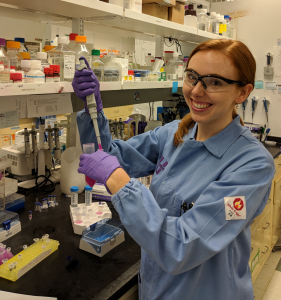Nanotechnology at Northwestern
Meet Janet Rose McMillan, a fourth-year graduate student in Professor Chad Mirkin’s lab
August 22, 2018
Where did you go to school, and when did you know that you were interested in chemistry?
I went to McGill University in Montreal. I think I knew when I started college that I really, really liked chemistry. Studying chemistry never felt like work; it was just so fun and interesting to me.
And how did you decide to focus on nanotechnology?
I had taken a couple of graduate-level survey classes of the literature from a couple of professors in my undergrad who were really excited about this field and really motivating. And so when I started looking at graduate schools and thinking about what sort of research I wanted to do, it just seemed like the most exciting field to be in.
How would you explain your current research in simple terms?
I’m trying to develop ways that we can take proteins and organize them into different kinds of materials. When I say proteins, these are the fundamental functional building blocks that make up all living systems. So you can think of them as the bricks or the Lego blocks that make up your body and every living thing. Nature’s very good at organizing those Lego blocks in such a way that it can do really, really complicated functions that chemists can’t imagine doing yet. But if we want to take these building blocks and bring them into the lab and make interesting kinds of structures with them, there’s really not a lot of very good tools to do that. So I’m trying to figure out what some methods are to be able to do exactly that.
So are you at the point of knowing what functions you’re aiming for, or is it more about figuring out how to put the pieces together at this stage?
Right now, I’m just trying to make the structures. We’re able to make one-dimensional stacks, and different types of crystals, but I think we’re getting very close to the point where we have a lot of structural control. We’re starting to think about what kinds of functions they could have, and what types of problems these materials could solve.
And what are the potential applications of your current research?
The state of my research right now is very fundamental, but there are a lot of potential applications that it could lead to in the future—for example, these materials could be important in bio-catalysis. A lot of proteins can do reactions that are chemically important, a lot easier than we can do with catalysts that we can make in lab. And oftentimes, it’s advantageous to tether together many different proteins that can mediate complementary reactions. They can also have applications in tissue engineering, where making materials where proteins can be organized in very precise ways at the nanoscale can affect how cells grow.
How do you see your career developing in the next five or ten years?
I’m interested in going into the chemical industry. I really love my time here, and learning how to do science and design experiments, and I know I still want to do that. But I’m also interested in seeing what it’s like to do that in a context where the research is a lot more applied, and you’re really making things that people are using every day.
What have you learned from your time in the Mirkin Research Group?
I’ve learned so much about the importance of collaboration. The projects I’ve seen have the most success have been the result of many students with different backgrounds working together, and the group is a great place to learn to do this well. Having so many students with different areas of expertise makes the Mirkin group a really great environment, and I’ve learned that the best ideas and solutions come from reaching out to talk to and work with people who have totally different backgrounds and perspectives from my own.
Interview and photo by Brooke Sprague.
The International Institute for Nanotechnology at Northwestern University is an umbrella organization that represents and unites more than $1 billion in nanotechnology research, education and supporting infrastructure.
